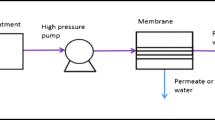Abstract
Today, the use of renewable energy such as wind energy and solar energy is very important due to its environmental friendliness. Solar energy is an important source of energy that has received special attention in recent years due to the rising cost of fossil fuels. In Iran, researchers and industry managers have attached special importance to the use of renewable energy. The purpose of this article is to use solar energy to supply desalination energy in Kish Island. In this study, thermodynamic and economic analysis of a combined reverse osmosis (RO) desalination system with a solar panel on Kish Island has been performed. Kish Island does not have a permanent river which does not have water all year around; hence, access to clean/fresh water, driven by solar power, on Kish Island as a tourism hub, has an effective role in preserving the environment and increasing the attractiveness of the island. Therefore, the supply of fresh water from the sea using water pre-treatment and reverse osmosis system can meet the need for a large part of the island for fresh water. In this study, the capacity of the desalination plant is about 7,200 cubic meters per day in order to supply fresh water to the urban population of the island (about 40,000 people). In designing the desalination unit to supply its energy requirement, first the appropriate membrane is determined from the simulation results and the power consumption of the system including pre-treatment and reverse osmosis system is calculated at 9,620,000 kWh of energy per year. According to the results, the total dissolved solids (TDS) of system effluent and Recovery percentage were 141.3 mg/L and 60.3%, respectively. Also, due to space constraints and based on the simulation results, in order to provide power consumption for the optimum case, 15,228 solar panel units have been proposed.





Similar content being viewed by others
References
Gocht, W., Sommerfeld, A., Rautenbach, R., Melin, T.H., Eilers, L., Neskakis, A., et al.: Decentralized desalination of brackish water by a directly coupled reverse osmosis photovoltaic system—a pilot plant study in Jordan. Renew. Energy 14(1–4), 287–292 (1998)
Petersen, G., Fries, S., Mohn, J., Muller, A.: Wind and solar powered reverse osmosis desalination units description of two demonstration projects. Desalination 31, 501–509 (1979)
Glater, J.: The early history of reverse osmosis membrane development. Desalination 117(1), 297–309 (1998)
Herold, D., Neskakis, A.: A small PV-driven reverse osmosis desalination plant on the island of Gran Canaria. Desalination 137, 285–292 (2001)
Thomson, M., Infield, D.: A photovoltaic-powered seawater reverse-osmosis system without batteries. Desalination 153(1–3), 1–8 (2002)
Mohamed, ESh., Papadakis, G.: Design, simulation and economic analysis of a stand-alone reverse osmosis desalination unit powered by wind turbines and photovoltaics. Desalination 164, 87–97 (2004)
Hrayshat, E.S.: Brackish water desalination by a standalone reverse osmosis desalination unit powered by photovoltaic solar energy. Renew. Energy 33, 1784–1790 (2008)
Khayet, M., Essalhi, M., Armenta-Deu, C., Cojocaru, C., Hilal, N.: Optimization of solar-powered reverse osmosis desalination pilot plant using response surface methodology. Desalination 261, 284–292 (2010)
Davies, P.A.: A solar-powered reverse osmosis system for high recovery of freshwater from saline groundwater. Desalination 271(1–3, 15), 72–79 (2011)
Compain, P.: Solar energy for water desalination. Proced. Eng. 46, 220–227 (2012). https://doi.org/10.1016/j.proeng.2012.09.468
Penate, B., Garcia-Rodriguez, L.: Current trends and future prospects in the design of seawater reverse osmosis desalination technology. Desalination 284, 1–8 (2012)
Shalaby, S.M.: Reverse osmosis desalination powered by photovoltaic and solar Rankine cycle power systems: a review. Renew. Sustain. Energy Rev. 73, 789–797 (2017)
Islam, S., Dincer, I., Yilbas, B.S.: Development of a novel solar-based integrated system for desalination with heat recovery. Appl. Thermal Eng. 129(25), 1618–1633 (2018). https://doi.org/10.1016/j.applthermaleng.2017.09.028
Ahmed, F.E., Hashaikeh, R., Hilal, N.: Solar powered desalination—technology, energy and future outlook. Desalination 453, 54–76 (2019)
Chen, C., Jiang, Y., Zhaoyong Ye, Y., Yang, L.H.: Sustainably integrating desalination with solar power to overcome future freshwater scarcity in China. Global Energy Interconnection 2(2), 98–113 (2019). https://doi.org/10.1016/j.gloei.2019.07.009
Mito, M.T., Ma, X., Albuflasa, H., Davies, P.A.: Reverse osmosis (RO) membrane desalination driven by wind and solar photovoltaic (PV) energy: state of the art and challenges for large-scale implementation. Renew. Sustain. Energy Rev. 112, 669–685 (2019). https://doi.org/10.1016/j.rser.2019.06.008
Monjezi, A.A., Yingxue Chen, R., Vepa, A.E.-H., Kashyout, B., Hassan, Gr., Fath, H.E.-B., Kassem, A.E.-W., Shaheed, M.H.: Development of an off-grid solar energy powered reverse osmosis desalination system for continuous production of freshwater with integrated photovoltaic thermal (PVT) cooling. Desalination 495, 114679 (2020). https://doi.org/10.1016/j.desal.2020.114679
Rahimi, B., Shirvani, H., Alamolhoda, A.A., Farhadi, F., Karimi, M.: A feasibility study of solar-powered reverse osmosis processes. Desalination 500, 114885 (2021)
Yanbolagh, D.J., Mazaheri, H., Saraei, A., Mehrabadi, S.J.: Experimental study on the performance of three identical solar stills with different heating methods and external condenser fully powered by photovoltaic: energy, exergy, and economic analysis. Energy Sources Part A Recovery Utilization Environ. Effects (2021). https://doi.org/10.1080/15567036.2020.1817187
Ahmadi, A., Noorpoor, A.R., Kani, A.R., Saraei, A.: Modeling and economic analysis of MED-TVC desalination with allam power plant cycle in Kish Island. Iran. J. Chem. Chem. Eng. (2021). https://doi.org/10.30492/IJCCE.2020.117914.3851
Nazarzadehfard, A., Saraei, A., Mehrabadi, S.J., Mohsenimonfared, H.: Exergy and thermoeconomic analysis of the combined MED desalination system and the Allam power generation system. Int. J. Energy Environ. Eng. (2021). https://doi.org/10.1007/s40095-021-00409-w
Author information
Authors and Affiliations
Corresponding author
Additional information
Publisher's Note
Springer Nature remains neutral with regard to jurisdictional claims in published maps and institutional affiliations.
Rights and permissions
About this article
Cite this article
Riyahi, N., Saraei, A., Vahdat Azad , A. et al. Energy analysis and optimization of a hybrid system of reverse osmosis desalination system and solar power plant (case study: Kish Island). Int J Energy Environ Eng 13, 67–75 (2022). https://doi.org/10.1007/s40095-021-00418-9
Received:
Accepted:
Published:
Issue Date:
DOI: https://doi.org/10.1007/s40095-021-00418-9




